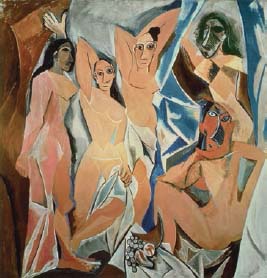From the Industrial Revolution to World War I, C. 1850–1914Early Twentieth-Century Art |
Why was Picasso’s Demoiselles d’Avignon so important? |
Picasso’s Demoiselles d’Avignon (1907) was significant because it shocked the early twentieth-century art world and foreshadowed Cubism and other forms of twentieth-century modernism. The large painting (7.9 x 7.6 feet), depicts a group of nude prostitutes with large, almond-shaped eyes, disjointed poses, and mask-like faces. The painting was radical for its subject matter as well as its incorporation of African style, especially on such a large scale. The painting was not necessarily a critical success and even Picasso’s friends found it to be ugly. However, the artist Georges Braque (1882–1963) saw the painting and was inspired by its broken lines and geometric dissolution of form. Demoiselles d’Avignon inspired Braque to experiment with a style that would be known as Cubism, one of the most significant revolutions in modern art.

Picasso shocked the art-viewing public with his “ugly” painting of prostitutes, Demoiselles d’Avignon (1907). Picasso’s interest in non-Western forms is evident in the mask-like faces of the nude figures. (Art courtesy The Bridgeman Art Library, © 2013 Estate of Pablo Picasso / Artists Rights Society (ARS), New York)
